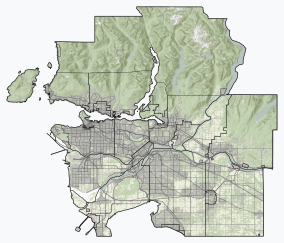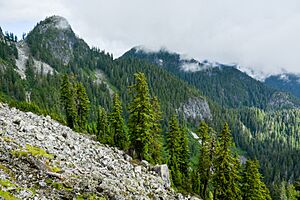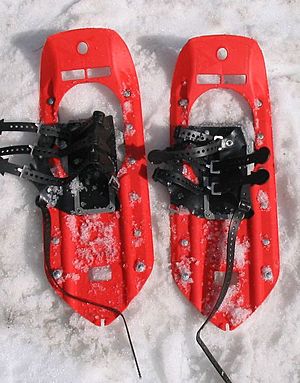Mount Seymour Provincial Park facts for kids
Quick facts for kids Mount Seymour Provincial Park |
|
|---|---|
|
IUCN Category II (National Park)
|
|

Mount Seymour Provincial Park. September, 2005
East slopes, looking north toward Mt. Elsay |
|
| Location | Metro Vancouver, British Columbia, Canada |
| Nearest city | North Vancouver |
| Area | 35 km2 (14 sq mi) |
| Established | 1936 |
| Visitors | 949,171 (in 2017-18) |
| Governing body | BC Parks |
Mount Seymour Provincial Park is a beautiful park in Vancouver, British Columbia. It's part of the North Shore Mountains. The park covers about 35 square kilometres and is located roughly 15 kilometres north of Downtown Vancouver. It was named after Frederick Seymour and opened in 1936. Mount Seymour Provincial Park offers many fun activities for visitors. It also provides a natural home for lots of different animals.
Contents
Exploring Mount Seymour's Geography
Mount Seymour Provincial Park is a wild mountain area. Several mountain peaks are inside the park. These include Mount Bishop, Mount Elsay, Runner Peak, and Mount Seymour. The park and its peaks are managed by the province. The highest point in the park is Mount Bishop, which is 1509 metres tall. Mount Seymour, which the park is named after, is 1449 metres tall.
The park also has several lakes. Elsay Lake is the biggest. Other lakes include Pencier Lake, Gopher Lake, and Goldie Lake. Many of these lakes flow into the Seymour River, which is west of the park.
Weather in the Park
Mount Seymour Provincial Park has an oceanic climate. This means it has mild temperatures and rain. The amount of snow depends on how high up you are. Higher parts of the park can get over 1000 centimetres of snow each year. Lower areas get around 100 centimetres of snow annually.
Animals and Wildlife in the Park

Mount Seymour Provincial Park is home to many different animals and plants. You might see bigger animals like deer and coyotes near the park's main road. Deeper in the park, you could spot black bears, bobcats, or cougars. To keep both animals and people safe, it's against the rules to feed or bother the wildlife. Groups like the BC SPCA work to protect these animals.
The park also has many smaller creatures and birds. Common birds include chickadees, sapsuckers, grouse, and siskin. You might also see Canada jays and ravens. The Steller's jay is often seen here and is the official bird of British Columbia. This bird was chosen in 1987 after a special campaign.
Here are some of the animals you can find in Mount Seymour Provincial Park:
| Big Animals | Small Animals |
|---|---|
| Coyote | Kinglet |
| Black bears | Grouse |
| Cougar | Douglas squirrel |
| Pine marten | Chickadee |
| Deer | Sapsucker |
| Bobcat | Siskin |
Plants and Trees in the Park
Mount Seymour Provincial Park covers about 3,508 hectares. It has many different types of plants and trees. You'll find tall, old Douglas fir trees and western red cedars. There are also younger coniferous (cone-bearing) and deciduous (leaf-shedding) trees. Higher up in the park, the forests change into open meadows. In these meadows, you can often see pretty sub-alpine flowers. Some examples are blu clematis, ballhead waterleaf, and Cusick's speedwell.
Mount Seymour Provincial Park has had problems with invasive plants. These are plants that are not native to the area. They can take over space and nutrients from native plants. This can harm the natural habitats. You might see clumps of Japanese knotweed in the park. Bull thistles are also common. Other invasive plants include St. John’s wort, Lamium, and Himalayan blackberry.
Japanese knotweed is harmful because it reduces the number of different plants in the area. This can affect the food chain. Its roots can also break off and float away, starting new patches. Yellow hawkweed can spread quickly in open areas. It can affect forests and areas that are trying to regrow.
Groups like the Invasive Species Council of Metro Vancouver (ISCMV) help manage these plants. They work to remove invasive species. The Invasive Species Council (ISC) of British Columbia also helps. They teach people how to identify and control invasive plants. They also organize "Community Weed Pulls" where volunteers help remove these plants.
Fun Activities in Mount Seymour Park
Mount Seymour offers many ways to have fun! There are many trails for mountain biking, hiking, and horseback riding on the lower part of the mountain. Higher up, you can enjoy picnics, skiing, snowboarding, snowshoeing, snowtubing, tobogganing, and camping in the backcountry. Different trails are used for different activities depending on the time of year. For example, some upper mountain trails are only for hikers.
Summer Adventures
Mount Seymour Provincial Park has 14 different hiking trails. They vary in how high they go and how hard they are.
| Trail Name | Difficulty | Length/ Elevation | Suggested Hiking Time | Starting/End Point |
|---|---|---|---|---|
| Old Cabin | easy | 430 metres/ 25 metres | 20 minutes | Parking Lot 1/ Perimeter Trail Junction |
| Dinky Peak | easy | 750 metres/25 metres | 15 minutes | Mount Seymour Trail/ Dinky Bluff |
| Mystery Lake | moderate | 1.5 kilometre/180 metres | 45 minutes | North end of Parking lot 4/ chairlift right-of-way to the lake |
| Perimeter | moderate | 1.5 kilometre/ 150 metres | 45 minutes | Deep Cove lookout/ Goldie Lake access trail junction |
| Goldie Lake Loop | easy | 2 kilometres/ minimal | 1 hour | First Aid building/ Goldie Lake |
| Mount Seymour | difficult | 4 kilometres/ 450 metres | 2.5 hours | First lake/ North end of the top parking lot/ Pump Peaks |
| Elsay Lake | difficult | 7 kilometres/ 500 metres | 9 – 10 hours | First Aid building/ -/back country shelter |
*Some information may be unclear.
You can only ride mountain bikes on special trails within the park. Some trails where mountain biking is not allowed include the Mount Seymour Main Trail and Mystery Lake Trail.
The Old Buck Trail is the only trail where you can ride horses.
There are several lakes in the park, like Goldie Lake, Flower Lake, and Mystery Lake. You can swim in them, but there are no lifeguards. If you have a valid fishing licence, you can fish in Elsay Lake. You can only reach this lake by hiking the Elsay Lake trail.
Winter Fun
In winter, the park offers trails for activities like snowshoeing and backcountry skiing. These trails are usually open from mid-December to March 31. Snowshoers, backcountry skiers, snowboarders, and hikers can all use these trails. You don't need a special pass or permit for the BC Parks Backcountry.
| Trail Name | Difficulty | Length | Suggested Time | Starting Point | View |
|---|---|---|---|---|---|
| Mount Seymour Backcountry Access trail | moderate - difficult | 7 km | 3 hrs on skis/ 4 hrs on snowshoes | Parking Lot 4 | views between the 1st and 2nd pump |
| First Lake trail | easy | 4 km | 1.5 hrs on skis/2 hrs on snowshoes | Parking Lot 4 |
Mount Seymour Ski Resort
| Mount Seymour Ski Area | |
|---|---|
| Location | British Columbia, Canada |
| Nearest city | North Vancouver, 15 km (9 mi) |
| Coordinates | 49°23′46″N 122°56′40″W / 49.39611°N 122.94444°W |
| Vertical | 330 m (1,083 ft) |
| Top elevation | 1,265 m (4,150 ft) |
| Base elevation | 935 m (3,068 ft) |
| Skiable area | 200 acres |
| Runs | 23 total 22% beginner 61% intermediate 17% expert |
| Longest run | 1.6 km (1 mi) |
| Lift system | 5 total 1 high speed detachable quad 2 double chairlifts 2 magic carpets |
| Snowfall | 1,200 cm (472 in) |
| Website | Mt. Seymour |
Mount Seymour is one mountain within Mount Seymour Provincial Park. It used to be run by the government for public recreation. In 1984, a private company called Mount Seymour Resorts Ltd. took over. Now, the company needs a special "park use permit" to offer activities. This permit allows them to provide fun services like skiing and snowboarding.
The Mount Seymour ski area has 4 ski lifts:
- the Mystery Peak Express quad chairlift
- Brockton double chairlift
- Lodge double chairlift
- Goldie Lake covered magic carpet
You can enjoy skiing and snowboarding on 39 marked trails and many other routes. The ski area has a vertical drop of 330 metres. There are also 18 trails open for night skiing. Mount Seymour has five special terrain parks for freestyle activities. These are Seymour Park, The Pit Terrain Park, Young Gun Terrain Park, Northlands Park, and Mushroom Park.
Mount Seymour Resorts also offers snow tubing and tobogganing at the Enquist Tube Park. This park has four tubing lanes that drop 100 metres. It also has eight toboggan lanes for sledding fun.
Images for kids







